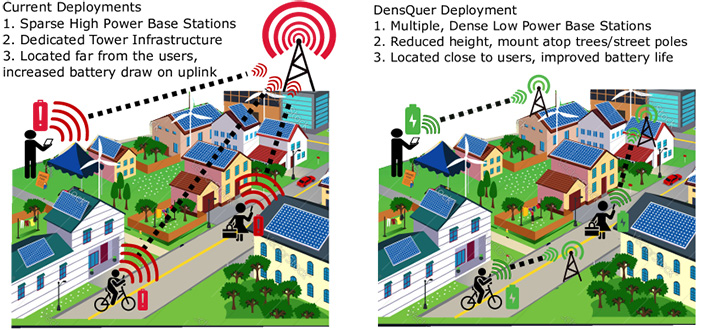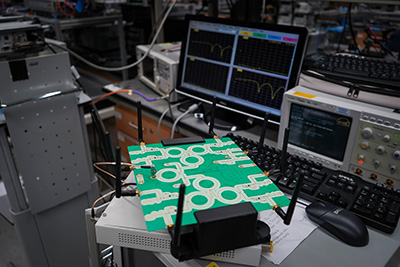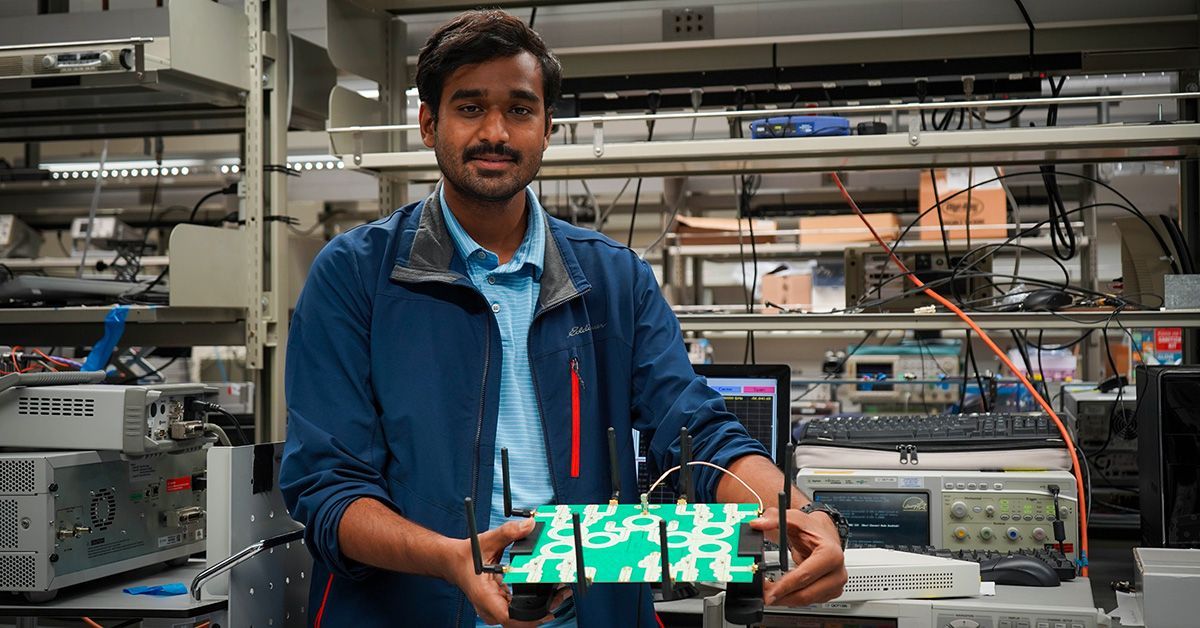Creating a “Greener,” More Connected Society
Two new approaches from UC San Diego lab promote energy-efficient wireless connectivity
Story by:
Published Date
Article Content
As the planet grapples with the climate crisis, researchers at UC San Diego have developed new technologies for more energy-efficient wireless connectivity with a reduced carbon footprint.
Described in two recent papers, a new base station deployment strategy and antenna design offer ways to reduce wireless energy demand and build more sustainable solutions in industry and research.
“Modern wireless technology continuously poses a dilemma: chasing faster data speeds frequently leads to significantly increased energy usage,” said Dinesh Bharadia, UC San Diego Qualcomm Institute (QI) affiliate and associate professor with the Jacobs School of Engineering’s Department of Electrical and Computer Engineering. “Our innovations stand as proof of our unwavering dedication to eco-friendly communications. We demonstrate that we can achieve faster data speeds while using less energy, paving the way for a sustainable, interconnected future.”
A sustainable framework
To tackle a challenge of this scale, a team of researchers from Bharadia’s lab started by envisioning a different way to connect to the wireless network.
Currently, wireless connectivity relies on towers or “base stations” that send out high-powered signals to customers across distances that can average up to a mile long. These signals must be strong enough to compensate for signal loss from striking, scattering or being absorbed by obstacles like buildings or natural parts of the landscape. As a result, the energy demand from base stations, and the corresponding drain on smartphone batteries, have created a significant carbon footprint.
Headed by Ph.D. student Agrim Gupta and fellow graduate students Adel Heidari and Jiaming Jin of Bharadia’s Wireless Communications, Sensing and Networking Group, the team developed a framework for replacing these tall, high-powered base stations with multiple smaller, lower-powered stations. Dubbed “DensQuer,” the proposed strategy uses Sionna, an open-source “digital twin” technology from Nvidia, to recreate a wireless environment virtually and plot out base station coverage tailored to specific urban landscapes.

Gupta and colleagues leveraged Sionna’s ray tracing technology to simulate the behavior of wireless signals from proposed DensQuer networks. Their results, backed by real-world data collected on UC San Diego campus, indicate that a more customized network accounting for a city’s features may require fewer, smaller base stations overall.
Some key results even indicated network power consumption dropped by about three times, while smartphone power consumption also decreased.
To measure exactly how much the proposed smaller, nearby base station network could reduce drain on cell phones, the researchers used an open-source tool recently released by Google to monitor a Pixel smartphone’s energy consumption at three locations, while connected to a base station on the roof of QI’s Atkinson Hall. Coupled with an antenna measuring the device’s transmit power, researchers detected an overall 10-15 decibel decrease in transmit power, corresponding to lower power consumption and a 50% increase in battery life while connected to the network.
“We want DensQuer to open more conversations about power consumption and 5G,” said Gupta. “What’s the roadmap to the next generation? We want to make that easier for end-users, while also helping the various operators that help create this almost omnipresent, sustainable wireless network.”
Researchers found that approximately 30-40 smaller base stations placed at a reduced height could match the coverage provided by a single, large base station on a cell phone tower. Due to their reduced height, a network of smaller base stations might be deployed across trees and street poles as part of the existing environment.
The team will next work toward efficiently orchestrating the network at a large scale, while preserving power savings and user experience.
Their paper, “Densify & Conquer: Densified, smaller base-stations can conquer the increasing carbon footprint problem in nextG wireless,” was made open-source to share the strategy widely with partners in industry and academia.
Streamlining the source

Another team from Bharadia’s lab, in collaboration with colleagues at the University of Colorado, Denver, focused on wireless antenna technology, which currently uses complex systems to connect with user networks. Referred to as Massive Multiple Input, Multiple Output (MIMO), these designs typically require multiple antennas to deliver data to diverse groups of customers simultaneously. While powerful, this technique has also come at the cost of greater carbon emissions.
The researchers set about designing a new approach to achieve the same output as a MIMO system with less energy demand. Their prototype, “GreenMO,” reduces the number of antennas needed by bundling the data streams collected by those antennas into a single, wideband radio frequency chain instead of many smaller bandwidth chains.
To accomplish this, the team had to design and build their own hardware. They tested GreenMO in Atkinson Hall on the UC San Diego campus, and found it three times as power-efficient as traditional Massive MIMO and four times more efficient in streaming data. In real-world simulations, the amount of power saved jumped to 50% in modern 5G base stations.
“There have been a few attempts to build a MIMO with a single [radio frequency] chain,” said Gupta, the paper’s lead author, “but to do it with a wideband waveform and obtain throughput results that are close to the current state of our technology at a very low power footprint is something GreenMO showed for the first time.”
Gupta presented “GreenMO: Enabling Virtualized, Sustainable Massive MIMO with a Single RF Chain” at the 29th Annual International Conference On Mobile Computing And Networking in Madrid, Spain. Co-authors and collaborators included Manideep Dunna of the Wireless Communications, Sensing and Networking Group, Eamon Patamasing of the UC San Diego Jacobs School of Engineering’s Department of Electrical and Computer Engineering, and Sajjad Nassirpour and Alireza Vahid of the University of Colorado, Denver.
In the future, Gupta and his colleagues plan to build a large-scale hardware test-bed combining DensQuer and GreenMO, taking a step toward achieving a sustainable vision for upcoming 6G networks.
Share This:
You May Also Like
Stay in the Know
Keep up with all the latest from UC San Diego. Subscribe to the newsletter today.




